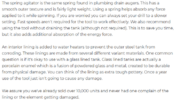I have water with high calcium and magnesium levels, and I prefer the minerality of it, so I didn't add a water softener when I bought this house. Sadly, this means I get sediment build-up in my hot water tank as well as on my fixtures. I clean the fixtures, no issue there, but the tank is a beast. The last time I flushed the tank it took FOREVER -- specifically because it was so sediment-laden I couldn't get decent flow out the drain port. That drove me so nutty that I haven't flushed it since ... so I know I'm overdue and this problem is likely far, far worse, now.
From the last flush I also know the janky, craptastic plastic hose bib at the drain port is part of my problem (i.e., no direct/straight path into the bottom of the tank) -- and that it needs to be removed and replaced with a nipple and ball valve for me to have any chance of flushing this system properly. That said, I'm fearful that it's become brittle with age and will likely break off when trying to remove it, so I'm thinking I should drain the tank PRIOR to removal and replacement. This concern informs my plan, which is as follows as a result of said concern:
Plan:
Would someone mind peer reviewing this? It feels overly complicated -- perhaps because of my worry about the breakage of the plastic drain port and hose connection (and the subsequent need to clean out the pipe threads with a Dremel, which I can only safely do if the water's been removed since it plugs into a wall socket.
Any advice on a better DIY way would be appreciated!
Surreal
P.S. Here's a turbo tank cleaner video for those unfamiliar with it (I haven't bought one yet -- plan comes first):
From the last flush I also know the janky, craptastic plastic hose bib at the drain port is part of my problem (i.e., no direct/straight path into the bottom of the tank) -- and that it needs to be removed and replaced with a nipple and ball valve for me to have any chance of flushing this system properly. That said, I'm fearful that it's become brittle with age and will likely break off when trying to remove it, so I'm thinking I should drain the tank PRIOR to removal and replacement. This concern informs my plan, which is as follows as a result of said concern:
Plan:
- Shut off electricity to water heater and well pump.
- Relieve hot and cold water pressure in the system.
- Remove the anode (which I intend to replace anyway, as It's probably due).
- Insert a transfer pump hose into the anode port and transfer all water I can out of the tank using a transfer pump.
- Once most water is gone, remove gimicky plastic hose bib at drain port.
- Replace plastic hose bib with a proper brass nipple and ball valve; close valve.
- Install old anode temporarily.
- Turn on electricity to well pump and purge air bubbles out of hot and cold lines, then close them.
- Open ball valve over a bucket and make sure tank is airlocked.
- Attach a turbo tank cleaner with hose to the ball valve and use it to flush the system until the tank sediment washes clean.
- Remove turbo tank cleaner, close ball valve, shut off electricity to well pump, open hot and cold fixtures to relieve any pressure.
- Remove old anode and replace with new one.
- Turn on power to well pump, ensure air is out of system, and close hot and cold fixtures.
- Call it a day after turning on power to water heater and cleaning up mess.
Would someone mind peer reviewing this? It feels overly complicated -- perhaps because of my worry about the breakage of the plastic drain port and hose connection (and the subsequent need to clean out the pipe threads with a Dremel, which I can only safely do if the water's been removed since it plugs into a wall socket.
Any advice on a better DIY way would be appreciated!
Surreal
P.S. Here's a turbo tank cleaner video for those unfamiliar with it (I haven't bought one yet -- plan comes first):
Last edited:


